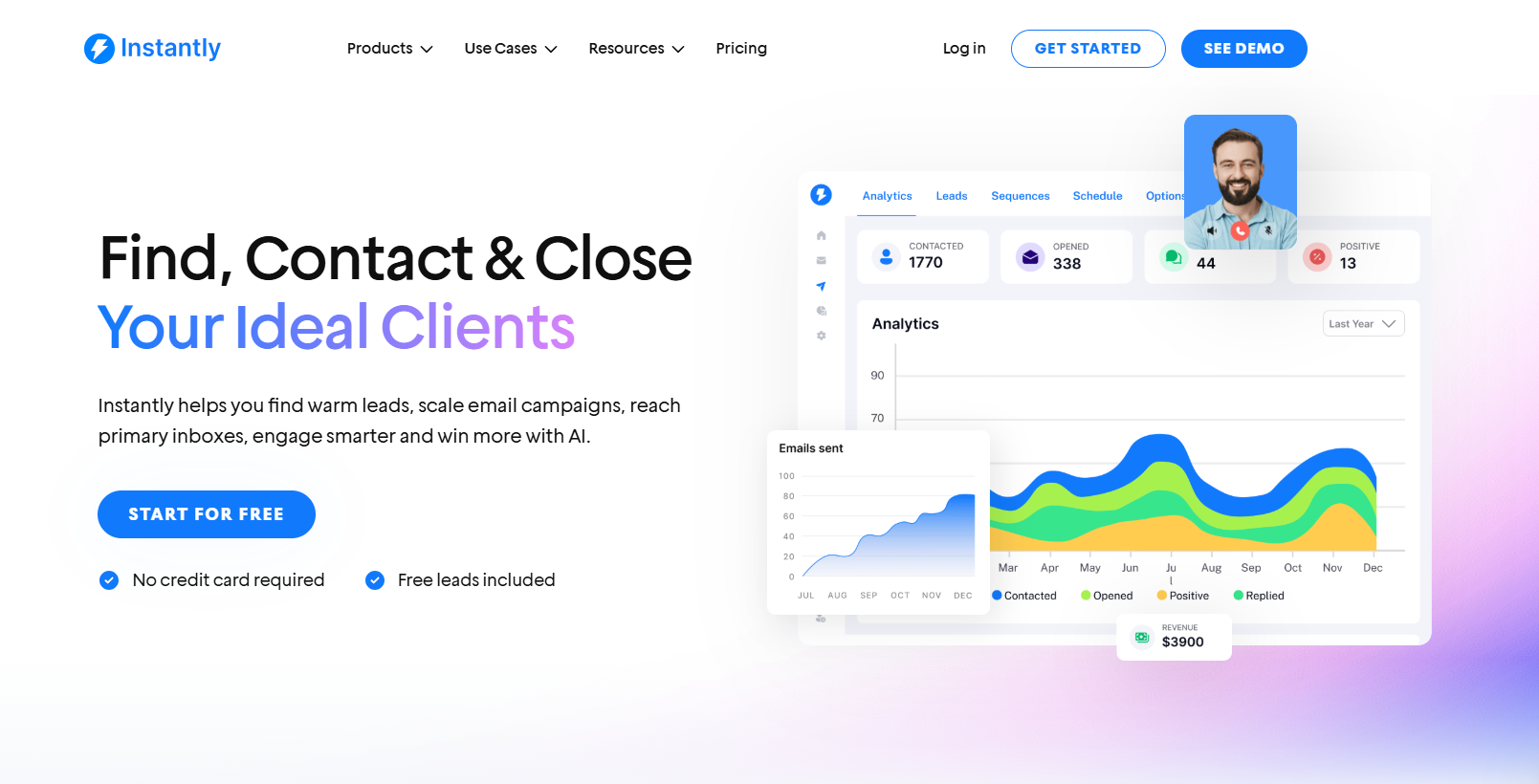Your prospect clicks your LinkedIn ad, clicks through to your landing page, and downloads your guide. Then... nothing happens for three days until they get a generic welcome email that never mentions their download. Guilty of this? It’s alright, a lot of us are.
Most businesses believe they're doing cross-channel lead generation when they're really just running separate campaigns that happen to target the same people. Effective cross-channel lead generation feels refreshingly connected.
Each touchpoint picks up where the last one left off. Your ad tees up your landing page. Your follow-up email continues the conversation, not restarts it. Your sales outreach builds on what the lead already knows, not what you assume they don’t. This kind of flow doesn’t just feel better; it works better.
Here's how to build lead generation sequences that actually work together. No more prospects falling through the cracks between channels. Just connected experiences that turn more prospects into customers.
Why Most "Cross-Channel" Strategies Are Just Expensive Multichannel Marketing
Your social media team runs LinkedIn ads promoting your new ebook and sees great response rates with lots of downloads. Meanwhile, your email team sends a welcome sequence about your company's history and values, while the retargeting team shows generic product ads to everyone who visited your site.
Each channel performed well individually, but the prospect's experience feels disjointed.
The Multichannel Trap Most Teams Fall Into
Most companies are doing multichannel marketing disguised as a cross-channel strategy. Sure, you're hitting multiple touchpoints, but there's zero connection between them.
Your LinkedIn ad promises insights about scaling revenue, then your welcome email talks about company values, and your retargeting ads push products they've never heard of.
The prospect has to start fresh with each interaction because your channels don't talk to each other. That LinkedIn download doesn't trigger relevant email content, their website behavior doesn't inform your social retargeting, and when they finally book a call, your sales team has no clue what content they've already consumed.
What Real Cross-Channel Integration Looks Like
Real cross-channel integration works like a good conversation. When someone downloads your revenue guide from a LinkedIn ad, that action triggers an email sequence with specific strategies for scaling revenue.
Your retargeting picks up the thread by showing case studies from similar companies, and your sales team gets notified when high-intent prospects are engaging across multiple channels.
Each touchpoint feels like the natural next step because it builds on what came before. Download the revenue guide? Your next email gives you implementation strategies, not a generic company overview.
Why Teams Get Stuck in Multichannel Mode
Most teams get stuck because their organizational silos mirror their tech silos. The email team lives in their marketing automation platform, social has its own tools, and sales practically lives in the CRM.
Everyone optimizes for their own channel metrics without seeing how the pieces fit together, so prospects end up confused, and conversion rates stay disappointingly flat. You end up paying premium prices for "cross-channel" strategies that deliver the same results as basic multichannel marketing.
The fix? Connected data, aligned teams, and sequences built around how prospects actually behave—not how your departments are organized.'
What Changed in 2025 (And Why Your Old Playbook Won't Work)
Remember when you could drop a pixel on someone's browser and follow them around the internet for months? Those days are gone, and they're not coming back.

Privacy Updates Killed Your Tracking (But Not Your Opportunities)
The iOS 14.5 update started the avalanche in 2021, but 2025 brought the full privacy reckoning. Apple's Mail Privacy Protection means your email open rates are basically fiction. Google's cookie deprecation finally happened. Third-party tracking got nuked across every major platform.
Your old playbook relied on following prospects around the web with retargeting pixels and email tracking. Now, you're flying blind if you haven't adapted, because you can't see who's engaging unless they choose to tell you.
The companies winning in this new reality aren't trying to track everything—they're creating experiences so valuable that prospects willingly engage across channels. When someone downloads your guide, engages with your email, and then visits your pricing page, they're giving you permission-based data that's way more valuable than any pixel ever was.
AI Raised the Bar for Personalization
Your prospects interact with Netflix, Spotify, and Amazon every day. These platforms deliver scary-good personalization that feels almost psychic. Now your B2B prospects expect the same sophistication from your marketing.
The good news? AI tools now make this level of email personalization achievable for companies without Netflix-sized engineering teams. The bad news? Your generic "Hope this email finds you well" approach looks painfully outdated by comparison.
AI can analyze prospect behavior across channels, predict their next likely action, and trigger the perfect follow-up automatically. But only if your channels are connected enough to feed the system good data.
Buyer Journeys Got Longer and More Complex
B2B buyers now research for months before engaging with sales. They expect to educate themselves through your content, compare you to competitors, and build internal consensus—all before they hop on a discovery call.
This extended research phase happens across multiple channels and touchpoints. They might discover you on LinkedIn, research on your website, engage with your email content, check out your case studies, then finally book a demo. If these touchpoints don't connect and build on each other, you're missing massive opportunities to guide their journey.
The companies capturing these long research cycles build sequences that nurture prospects through months of consideration, not just weeks.
The Integration Imperative
All these changes point to the same conclusion: disconnected channels don't just underperform anymore—they actively hurt your results. When prospects can't be tracked, when they expect personalization, and when their journeys are complex, your only option is creating connected experiences that work together seamlessly.
Your 2025 lead generation strategy needs to assume zero tracking, deliver high personalization, and guide complex buyer journeys. The old multichannel playbook can't handle any of these requirements.
How to Build Lead Generation Sequences That Actually Connect

Most teams approach sequence building backwards. They plan emails first, then try to figure out how other channels can support them. This creates email-centric sequences with everything else bolted on as an afterthought.
Connected sequences start with prospect behavior, not channel capabilities. When someone takes a specific action, what's the most logical next step for them? Then you work backwards to figure out which channels deliver that next step most effectively.
Map Your Prospect's Journey First
Before touching any automation tools, grab a whiteboard and map out how prospects move through your funnel. Not how you want them to move, but how they actually do.
Start with high-intent actions that signal buying readiness. Someone downloads your pricing guide, visits your case studies page, or watches a product demo. These aren't just engagement metrics—they're signals about where prospects are in their decision process.
Then identify the natural next step for each action. Downloaded the pricing guide? They probably want to see ROI calculations or customer success stories. Watched the product demo? They might need technical documentation or implementation timelines.
Each action should trigger the next logical piece of content through the most effective channel. Sometimes that's email, sometimes it's retargeting, sometimes it's a direct sales outreach. The channel choice depends on the content and timing, not departmental preferences.
Build Trigger-Based Response Systems
Your email sequences need to respond to what prospects do, not just when they do it. Time-based sequences miss the mark because they ignore engagement signals. A prospect who opens every email and clicks multiple links is ready for different content than someone who's gone cold for three weeks.
Set up behavioral triggers that activate different sequence paths. High engagement scores trigger accelerated sequences with more direct sales content. Low engagement triggers re-engagement campaigns with educational materials. Zero engagement for 30 days moves them into a nurture sequence designed to reactivate interest. Instantly.ai excels at these behavioral triggers.

With powerful engagement-based automation, proven email templates for every sequence type, and AI-backed campaign workflows, you can set up smart, reactive journeys that adapt with every click, open, or silence. Try Instantly for free.
Create Content That Connects Across Channels
Each piece of content should acknowledge what came before it and set up what comes next. Your LinkedIn ad mentions a specific challenge, so your landing page addresses that exact challenge. Your email sequence builds on concepts introduced in the download, and your retargeting reinforces the solutions discussed in your emails.
This isn't about repeating the same message everywhere—it's about creating a conversation that progresses naturally from one touchpoint to the next. Each interaction should feel like the logical continuation of the relationship, not a random interruption.
Your sales team needs to be part of this conversation, too. When they reach out, they should reference specific content the prospect engaged with and build on those interactions instead of starting from scratch.
Example: The Connected Revenue Growth Sequence
Here's how a complete sequence works when all channels connect:
A prospect clicks your LinkedIn ad about "scaling revenue without scaling headcount" and downloads your guide. This action triggers an email sequence focused on revenue efficiency strategies, with each email building on concepts from the guide.
Meanwhile, your retargeting shows case studies of companies that scaled revenue using those exact strategies. If they visit your case studies page, it triggers a sales alert with context about their interests and engagement level.
Your sales rep's outreach references their guide download and case study views: "Saw you checked out how Acme scaled to $10M without adding sales reps. Happy to show you how their approach might work for your situation."
When your email automation integrates with your CRM (like Instantly's native integration), your sales team automatically gets this engagement context without manual tracking.
Every touchpoint builds on previous interactions while moving the conversation forward. The prospect never feels like they're starting over or receiving irrelevant content. This kind of connected experience only works when your channels share data and your content strategy considers the entire journey, not just individual touchpoints.
Key Takeaways
Cross-channel lead generation isn't about using more channels, but about making them work together. The companies winning in 2025 create connected experiences where each touchpoint builds on the last, guiding prospects through longer, more complex buyer journeys.
Start by mapping how prospects actually move through your funnel, then build trigger-based sequences that respond to behavior, not just timing. Your LinkedIn ads should inform your email content, your website behavior should trigger relevant retargeting, and your sales team should know exactly what content prospects consumed before reaching out.
The old spray-and-pray multichannel approach died with third-party cookies. Connected sequences that deliver value at every step are the new standard.
Ready to build lead generation sequences that truly connect? Start your free Instantly trial to see how automated email sequences integrate with your broader cross-channel strategy.




